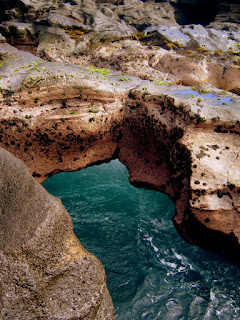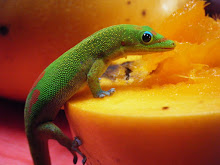
We drove into the fading darkness through coffee country down the winding road to Neverland. Every time I drive by this part of the island I nearly drive off the road from peering over the cliffs, looking for a way to get down to the ocean. The surrounding land is private so that basically eliminates getting to the coast by land. What better way to explore the rugged coast than by way of sea. The turbulent water off the point is the place where winds and currents converge making the ocean come alive! We planned on paddling to Wai’ahukini a white sand beach about a mile and a half away along the cliffs.


I had my lay down paddle board and my friend Patrick was on his stand up board.
With the winds whipping I somehow managed to scamper down the cliff holding on to my 14ft board without disaster.

Getting into the water was a little tricky; we had to time when a wave was coming and just jump and go for it. I made it into the clear water unscathed. Patrick was not as lucky, being hit by a breaking wave and thrown back into a rock. He didn’t know it then but one of his fins was knocked out.


The sun weaved webs of light that appeared to hang from the jagged cliffs as we paddled along with the wind on our backs. Going with the wind, we made it to the desolate windswept beach in no time.It was hard to find an opening amongst the jagged lava rock and breaking waves, trying to make it onto shore. Again we had to just go for it and hope for the best. We both made it in without hitting any rocks and marveled at the surrounding landscape of giant sand dunes, colorful cliffs, vibrant blue ocean, and Mauna Loa sitting quietly in the distance.

I had heard that there are a few surf spots near but access was extremely difficult by land. The big limiting factor is the near vertical cliff face that must be scaled in order to reach the ocean. I saw the rope dangling down and wondered how anyone could make it down with a board. We walked along the beach like shipwrecked wanderers over white and dark green sand beaches towards the old village of "K". Once a thriving fishing village until the lava flow of 1868, "K" is now just a name almost forgotten by time.
The small bay formed by the flow created a surf break that breaks when the stars are aligned. This day the waves were gentle and rolling. Smooth stone lined the shallow bottom making it fun for bodysurfing.

Rock wall ruins stood as symbols of the old village. The ruins created a feeling that was eerie, calm, and quiet but somehow peaceful at the same time.
Hoping over the jagged lava rock trail, we kept moving forward in awe of the surroundings and losing track of time.

When we turned around we were shocked to see the cliff where we started way off on the horizon. The giant cinder cone of Pu’u Hou towered in front and seemed to be rising from the sea. We kept walking towards it and found that unreal black sand beaches were at the base of the cinder cone.

The first thing I want to do when I see a pristine beach with no footprints is run as fast as I can along the waters edge, hooting and rolling around in the sand. Yes I did all of that! My footprints will be washed away for the next fortunate person who marvels at the place where the soft black sand meets with the cliffs and ocean.


When we made it back to the lone tree which we left our boards under and Patrick realized one of his fins was missing. As I started to laugh, a gust of wind sent my giant board tumbling down the beach like an inflatable raft. I chased it down the beach and watched in horror as it banged into sharp rock after rock. Yes there are many new dings and scrapes on my board but it’s hard not to laugh at such a thing. The paddle back into the now heavy wind was not was easy. I was laughing like a lunatic as my board went up and down in the chop, with the wind blowing a salty spray into my face. Patrick was like a sail trying to stand up and paddle hid board into the wind. He was forced to lie down and paddle the way back. An amazing day of exploring remote beaches and paddling through rugged and raw waters, feeling the heartbeat of the Ocean.
Seeing dreams in the reflections

































5 comments:
Billy: I came across your fascinating post while trying to find info on accessing Wai'ahukini and Pu`u Hou. I have heard of a surfers access with a rope dropping off the pali as you describe (so one doesn't have to go by sea from South Point) but where to access that? Any beta you can provide would be appreciated. Many thanks from Seattle.
KAPU! Please take this down. Sacred (1st ancient Hawaiian landing site, water source, and oldest carbon-dated Hawaiian artifacts, Goddess Pele sparing the village in 1868) secrets (you want to go when you are 60 and see footprints and trash everywhere like any other place here?) should remain secret to preserve the perfect state of the place and out of respect for the hundreds of thousands of ancient Kanaka Maoli souls resting there. Wait for humanity to catch up. Keep aquarium collectors and the unconscious in the less sacred and not perfectly preserved places. Nowhere else in Hawaii is left that is this pristine. NOWHERE. Your pix are THE ONLY pix of this place on the internet. PLEASE, i beg of you, REMOVE. KAPU!
Anonymous, I respectfully disagree with your comment. This beautiful place exists for anyone willing to make the trek. There are not many people willing to go down there because it is very hard to access. Therefore, most people such as myself that do go appreciate, admire, and respect the beauty. There is plenty of trash down there, left by fishermen..... I will remove the name, fair compromise?? People deserve to be educated about such places, then maybe they would respect more. Throwing out the word "KAPU" is not a valid reason and is religious in nature, which I disagree with. All wild places and the whole island really, is a special place.
Side note- recent re-dating (Mulrooney, 2014) of charcoal from that site by Bishop Museum and UH Manona, from the famous H8 rock shelter excavation, suggests that it wasn't inhabited much before 1350, and the main pavement wasn't laid down until mid-1600's-1700's. They find the site was inhabited more-or-less continuously during that period up until the early 1860's, but, "...does not represent a site of early colonization of the archipelago." This came as a surprise to many, although Y. Sinoto is an author on the work as well. He was among the first to do careful excavation of the site going back to 1959. Of course it is a very special place, preserving a remarkable history and deserves all the respect, care and love of all wild places.
Wow, thank you for sharing! I agree: Respect, care, and love for the land. Understandably, land use is a very big issue for the state. There are many sides, with many intentions. I think the best way for all sides to understand each other is to have dialogue and empathy.
Post a Comment